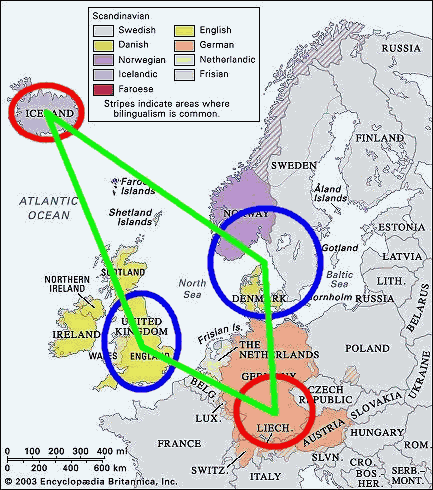2025-07-21 Mon
■ #5929. but の前置詞と接続詞の用法,および格支配の問題 [but][preposition][conjunction][case][german][danish][prescriptive_grammar]
昨日の記事「#5928. 多義語 but」 ([2025-07-20-1]) に続き,but の話題.but には「~を除いて」を意味する前置詞および接続詞の用法がある.前置詞であれば後続するのは常に目的格であり,接続詞であれば,それが導く節内での役割に応じて格が決定される,というのが理屈である.しかし,これはあくまで理屈にとどまり,必ずしも現実の事例に反映されているわけではない.例えば,文のなかで要求されている格が何であれ,no one but me もあれば no one but I もある.これは何の問題なのだろうか.
Jespersen に "Preposition and Conjunction" と題する詳しい記述がある (§6.3) .以下に,その記述の最初の部分に相当する1節を引用する.
6.31. A good deal of confusion arises from some words being both prepositions and conjunctions. A characteristic example is but; cf NED with examples, especially under the heads C. 3 and 4. It should, however, be noted that the confusion in the use of but is not, as said in NED, a consequence of the want of distinct case-endings in the nouns and the use of the obl. case instead of the nom. in other connexions. In my opinion, on the contrary, the existence of such two-sided words as but, etc, is one of the primary causes of mistakes of me for I or vice versa, and careless uses of the cases generally. Even in such a language as German, where the cases are generally kept neatly apart, we find such combinations as "niemand kommt mir entgegen ausser ein unverschämter" (Lessing); "wo ist ein gott ohne der herr" (Luther); "kein gott ist ohne ich," etc. See Pau, Principien4 372; In Danish similar examples abound (ingen uden jeg, etc).
If we use in one place the term preposition and in another conjunction in speaking of such words, the real meaning is that in one case the word concerned is definitely felt as part of the (main) sentence (no one but me),
引用後半にあるように,この問題と混乱は,英語史を通じて名詞(句)の格の区別が形態的に明示されないようになったために生じたという見解がある.しかし,Jespersen はむしろ逆の考え方を提案している.but が前置詞でもあり接続詞でもあるという2面的な性質を示すがゆえに,一般的な格の混同が助長されたのだというのだ.はたして鶏が先か,卵が先か?
・ Jespersen, Otto. A Modern English Grammar on Historical Principles. Part 7. Syntax. 1954. London: Routledge, 2007.
2012-09-02 Sun
■ #1224. 英語,デンマーク語,アフリカーンス語に共通してみられる言語接触の効果 [germanic][inflection][synthesis_to_analysis][contact][danish][afrikaans][bilingualism]
[2011-11-10-1]の記事「#927. ゲルマン語の屈折の衰退と地政学」で,O'Neil を参照しつつ,英語が古ノルド語と接触して屈折が簡単化したのと同様に,大陸スカンジナビア諸語が低地ドイツ語 (Middle Low German) と接触し,アフリカーンス語 (Afrikaans) がオランダ語 (Dutch) や低地ゲルマン語 (Low German) と接触して,屈折が簡単化したことに触れた.
同じ趣旨の言及が,Görlach (340) で,他の研究の要約という形でなされていた.デンマーク語 (Danish) は,13--15世紀に屈折の大部分を失った.この時期は,デーン人がデンマーク語と低地ドイツ語の2言語使用者となっていた時期である.そして,この2言語は,英語と古ノルド語の関係よろしく,語彙は概ね共通だが,屈折が大きく異なるという関係にあった.
アフリカーンス語については,1700--1750年の時期に,英語やデンマーク語と同様の著しい水平化が生じた.Cape Province の植民者の35%はオランダ系,35%はドイツ系で,人々は様々な屈折の差異を示しながらも,主として分析的な統語手段に依存して意志疎通を図っていたとみられる.
いずれの場合にも,同系統に属する2言語の接触が関わっており,かつ両言語のあいだに明確な社会的上下関係のないことが共通している.標題のゲルマン3言語の平行関係には偶然以上のものがあると考えてよさそうだ.
なお,クレオール語説は,中英語のみならずアフリカーンス語についても唱えられているようだ.そして,ロマンス諸語にも.Görlach の References を参照.
・ O'Neil, Wayne. "The Evolution of the Germanic Inflectional Systems: A Study in the Causes of Language Change." Orbis 27 (1980): 248--86.
・ Görlach, Manfred. "Middle English --- a Creole?" Linguistics across Historical and Geographical Boundaries. Ed. D. Kastovsky and A. Szwedek. Berlin: Gruyter, 1986. 329--44.
2011-11-10 Thu
■ #927. ゲルマン語の屈折の衰退と地政学 [germanic][inflection][synthesis_to_analysis][contact][geography][map][dutch][german][faroese][icelandic][danish][afrikaans]

中世のゲルマン語派の話者の分布を地図に示すと,北東端を Continental Scandinavian,南東端を High German,南西端を English,北西端を Icelandic にもつ四辺形が描かれる.この地図が示唆する興味深い点は,青で示した English と Continental Scandinavia は歴史的に屈折を激しく摩耗させてきたゲルマン語であり,赤で示した Icelandic と High German は歴史的に屈折を最もよく残してきたゲルマン語であるという事実だ.そして,革新的な北東・南西端と保守的な北西・南東端に囲まれた,緑で示した四辺形の中程に含まれる Faroese, Dutch, Frisian, Low German は,屈折をある程度は摩耗させているが,ある程度は保持しているという中間的な性格を示す.この地理と言語変化の相関関係は見かけだけのものだろうか,あるいは実質的なものだろうか.
この点について好論を展開しているのが,O'Neil である.
Now from the point of view of their inflectional systems, it is in the languages of the extreme southwest and northeast areas, among the Scandinavians and the English, that things are farthest from the state of the old languages, where --- in fact --- the old inflectional system has become so simplified that the languages can barely be said to be inflected at all. It is in the other two areas, in the northwest in Iceland and in the southeast among the High Germans (but most especially in Iceland) that an older inflectional system is best preserved. Between these two extremes and their associated corners or areas and languages, lie other Germanic languages (Faroese, Frisian, Dutch, etc.) of neither extreme characteristic: i.e. not stripped (essentially) of their inflections, nor heavily inflected like the older languages. (250)
地理が直接に言語の変化に影響を及ぼすということはあり得ない.しかし,地理が言語話者の地政学的な立場に影響を及ぼし,地政学的な立場が歴史に影響を及ぼし,歴史が言語の発展に影響を及ぼすという間接的な関係を想定することは可能だろう.
屈折が大いに単純化した英語の場合,古ノルド語 (Old Norse) との接触が単純化の決定的な引き金となったという論は,今では広く受け入れられている([2009-06-26-1]の記事「#59. 英語史における古ノルド語の意義を教わった!」を参照).一方で,アイスランド語 (Icelandic) が地理的に孤立しているがゆえに,古い屈折を現代までよく残しているということもよく言われる([2010-07-01-1]の記事「#430. 言語変化を阻害する要因」を参照).いずれも歴史的に経験してきた言語接触の程度との関数として説明されているが,その言語接触の歴史とは地政学上の要因によって大いに条件付けられているのである.ここでは言語変化が地理的条件により間接的に動機づけられているといえるだろう.
では,英語やアイスランド語以外のゲルマン諸語についても,同様の説明が可能だろうか.O'Neil は,大陸スカンジナビア諸語の屈折の単純化も英語のそれと平行的な関係にあると主張する.この場合,大陸スカンジナビア諸語が接触したのは低地ドイツ語 (Middle Low German) である.
It is clear then that Continental Scandinavian is inflectionally simple like English, with --- however --- its idiosyncratic sense of simplicity. The reasons for its simplicity seem to be exactly those that led to the development of the neutralized northern Middle English inflectional system: language contact between Middle Low German and Danish in the countryside and between Middle Low German and all Continental Scandinavian languages in the centers of trade. (267)
さらに,英語や大陸スカンジナビア諸語と同じように単純化した屈折をもつアフリカーンス語 (Afrikaans) についても,同様の議論が成り立つ.ここでは,オランダ語 (Dutch) と低地ゲルマン語 (Low German) との接触が関与している.
. . . the original population that settled Capetown and then the Cape was not a homogeneous Dutch-speaking population. The group of people that arrived in Capetown in 1652 was first of all predominantly German (Low German mercenaries) and the Dutch part of it was of mixed Dutch dialects. Thus just the right conditions for the neutralization of inflections existed in Capetown at the time of its settlement. (268--69)
他にも,フリジア語 (Frisian) とオランダ語 (Dutch) とが都市部で言語接触を経験した結果としての "Town Frisian" (268) の例も挙げられる.
反対に,複雑な屈折を比較的よく保っている例として,アイスランド語の他に挙げられているのが高地ドイツ語 (High German) である.ここでも O'Neil は,高地ドイツ語もアイスランドほどではないが,地政学的に見て隔離されていると論じている.
. . . High German has not been so completely isolated as Icelandic. But then neither is its inflectional system as conservative. Yet in fact the area of High German has been generally isolated from other Germanic contact --- the sort of contact that would lend to neutralization, for the general motion of High German has always been away from the Germanic area and onto its periphery among non-Germanic peoples. (277)
最後に,地図上の四辺形の内部に納まる中間的な屈折度を示す言語群についても O'Neil は地政学的な相関関係を認めているので,指摘しておこう.以下は,フェロー語 (Faroese) の屈折の中間的な特徴を説明づけている部分からの引用である.
. . . the Faroese fished and worked among the Icelanders and still do, at the same time being administered, educated, and exploited by continental Scandinavians. Thus for centuries was Faroese exposed to the simplified inflectional systems of continental Scandinavia while in constant contact with the conservative system of Icelandic. Unless this conflict was resolved Faroese could neither move toward Continental Scandinavian, say, nor remain essentially where it began like Icelandic: neither completely neutralize its inflections, nor simplify them trivially. The conflict was not resolved and as a consequence Faroese moved in a middle state inflectionally. (280)
・ O'Neil, Wayne. "The Evolution of the Germanic Inflectional Systems: A Study in the Causes of Language Change." Orbis 27 (1980): 248--86.
Powered by WinChalow1.0rc4 based on chalow